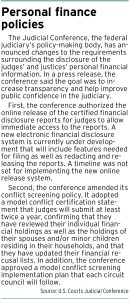Subscriber Benefit
As a subscriber you can listen to articles at work, in the car, or while you work out. Subscribe NowGiven that what federal judges do with their money outside the courthouse has raised questions about whether they are ruling in favor of their financial interests inside the courtroom, the federal judiciary is making changes that members of the legal community and court observers say are good but do not go far enough.
The U.S. Judicial Conference, the federal judiciary’s policy-making body, recently announced plans to automate the release of judges’ financial disclosure statements and amendments to its conflict screening process. The steps are being touted as bringing more transparency and helping restore the public’s confidence in the federal courts.
Already, federal judges are required by law and by the Code of Conduct for United States Judges to keep abreast of their financial interests and to disqualify themselves from presiding over any cases where those interests are represented. However, an investigation by the Wall Street Journal found that between 2010 and 2018, more than 130 judges ruled on cases in which they had a financial stake.

Senior Judge G. Michael Witte, who served as executive director of the Indiana Supreme Court Disciplinary Commission for 39 years, said he does not believe the judges were intentionally trying to enrich themselves. Rather, he speculated, the judges’ failures to recuse stemmed in part from a complacency that sprouts from having a lifetime appointment to the bench.
Still, Witte did not excuse the behavior.
“You hope that people who are appointed as judges at the federal level recognize that it is a huge undertaking and what is being placed upon their shoulders — not just being a decision-maker, but being a guardian of a form of government and guardian of a constitution,” Witte said. “So don’t play fast and loose with it.”
The announcement from the Judicial Conference came in the wake of two bills moving through Congress that tighten the personal financial reporting requirements for federal judges. In February, one bill, the Courthouse Ethics and Transparency Act had such strong bipartisan support that it was passed by the U.S. Senate on unanimous consent.
Gabe Roth, executive director of Fix the Court, a nonpartisan nonprofit, said he hopes Congress will not be “bullied by the Judicial Conference” into letting the legislation die. Although he has concerns that the judges are not being completely honest in their disclosure and conflicts statements, Roth, like Witte, attributed the lax attitude toward reporting to the judges being appointed for life and from working under little public scrutiny.
Getting the Senate bill passed into law, Roth said, would make the financial disclosures filed by judges publicly accessible just like those filed by politicians.
“I don’t know if it’ll make better judges, but I think it’ll make more ethical judges,” he said. “I think it’ll make oversight easier for the litigants and for the public.”
‘Bad signal’
The fire ignited by the WSJ investigation was acknowledged by U.S. Supreme Court Chief Justice John Roberts in his 2021 Year-End Report. Roberts noted that over the nine years of court decisions the newspaper reviewed, the federal judiciary had a 99.97% compliance rate with the rules for recusal.
Yet, he noted, the problem could not be ignored.
“We are duty-bound to strive for 100% compliance because public trust is essential, not incidental, to our function,” Roberts wrote in the report. “Individually, judges must be scrupulously attentive to both the letter and spirit of our rules, as most are.”
The Judicial Conference responded by authorizing the financial disclosure reports to be released online. Also, the conflict statements must be submitted by each judge at least twice a year and must undergo screening to identify any conflicts that would require recusal.
 The financial disclosure reports include a judge’s noninvestment income, reimbursements for job-related travel, gifts and investments. The conflict statements, which are not public, contain financial information along with details on any personal connections to individuals or organizations.
The financial disclosure reports include a judge’s noninvestment income, reimbursements for job-related travel, gifts and investments. The conflict statements, which are not public, contain financial information along with details on any personal connections to individuals or organizations.
Charles Geyh, professor at Indiana University Maurer School of Law, described the conference’s actions as “meaningful.” But Geyh said he sees the federal judiciary continuing its practice of reacting to problems rather than being proactive by appointing a committee, examining an issue and taking preventative steps to avoid a crisis.
He maintained that the amount of holdings unearthed by the WSJ were so small that no reasonable person would think the judges were acting in their own self interests. Many people probably would not question the impartiality of a judge who has “a trivial number of shares in a company,” he said.
The real problem, he said, is judges’ attitudes toward 28 U.S.C. § 455, which requires disqualification in certain cases.
“When you’ve got hundreds of examples of judges disregarding the law, even if the disregard isn’t evidence of corruption, it’s not evidence of self-dealing, it is simply evidence that you don’t think the law warrants your attention, that it’s too trivial to worry about, that sends a bad signal,” he said. “That sends a signal that judges are indifferent to following the law that they’re bound to uphold, and that’s a problem.”
Restoring public trust
In both the Southern and Northern Indiana district courts, conflict statements are run through automated screening software that is available through the CM/ECF filing system when judges are assigned cases. Judges must also manually screen for conflicts because the automated system is imperfect, either failing to identify conflicts or mistakenly flagging things that are not included in the conflict statement.
 The WSJ investigation found only one problematic case in Indiana. Judge James Sweeney in the Southern Indiana District Court presided over the dispute.
The WSJ investigation found only one problematic case in Indiana. Judge James Sweeney in the Southern Indiana District Court presided over the dispute.
Filed in October 2018 — about two months after Sweeney took a seat on the federal bench — Arthur v. Wal-Mart Stores East LP, 1:18-cv-03349, was a personal injury case against Walmart in Johnson County. Magistrate Judge Tim Baker handled all the proceedings, which by the spring of 2019 had ended with a settlement.
Sweeney never made a ruling in the case. However, just three months after he signed the dismissal order, the Southern Indiana District Court sent a letter to the litigants stating the judge owned stock in the big box retailer. Sweeney’s 2018 financial disclosure form available on the Free Law Project website shows his stock in Walmart was valued between $1 and $15,000.
The court’s letter maintained Sweeney’s stock ownership did not affect his actions in the case, but he should have recused himself. As a result, the parties were told any response they had to the disclosure would be considered by another judge of the court.
The docket does not show any additional entries after the clerk’s letter.
Curt Levey, president of nonprofit group The Committee for Justice, said the fact that Sweeney did not have to rule is “only somewhat reassuring.” He pointed out lawyers’ decisions are influenced by what they anticipate the judge will do, so just having a judge assigned a case could impact how the dispute is litigated.
Moreover, Levey noted that even with the amended conflict policy, judges do not have to step aside every time they have a financial interest in the case. Yet, he said he still sees a benefit coming from the revised policy.
“You would hope,” Levey said, “that going through the process would make them more aware of it and more likely to disclose the conflict knowing the evidence of it will be online or easily available.”
Witte said he hopes the judges will pay more attention so as to counter the growing public perception that the courts work at the behest of whoever is in power.
“In order to get people to go back to their basic civics education and understand that the judiciary is a separate, co-equal branch of government that has independence from the other two branches of government, as far as decision-making and interpreting laws and interpreting the Constitution, I think this move toward transparency hopefully gets the public to understand that,” Witte said. “I think it’s also a good move, because by not having that level of transparency, I think it undercuts the public’s trust and confidence.”•
Please enable JavaScript to view this content.

